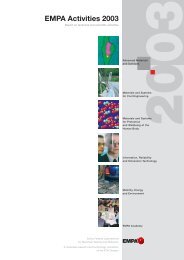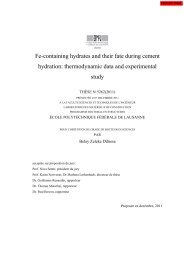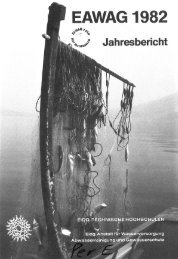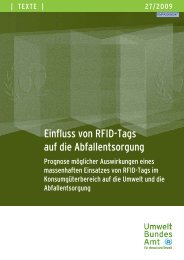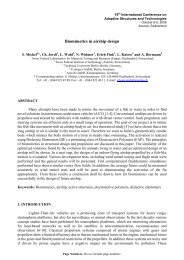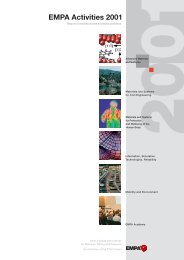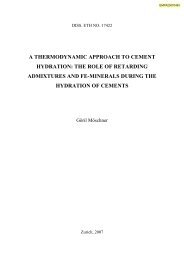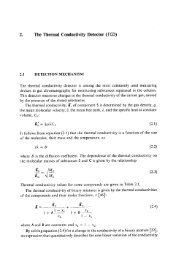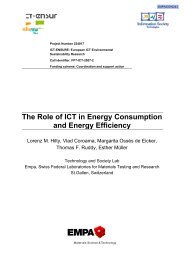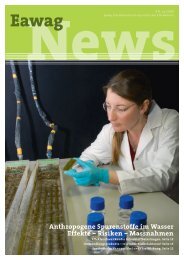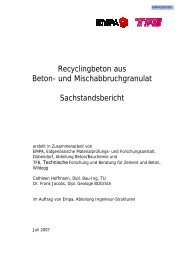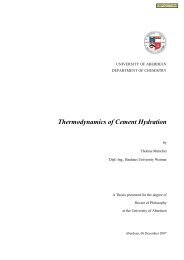Entire volume - Eawag
Entire volume - Eawag
Entire volume - Eawag
You also want an ePaper? Increase the reach of your titles
YUMPU automatically turns print PDFs into web optimized ePapers that Google loves.
Kallavesi corresponds to 43% shared variance;<br />
i.e., 43% of the variability in the breakup<br />
date can be explained statistically by the<br />
variability of the NAO index. This is a surprisingly<br />
high figure in view of the simplicity<br />
of the NAO index as a representation of<br />
the complex climatic effects operating on<br />
the lake.<br />
The Lej da San Murezzan, in the Swiss Alps,<br />
is situated in a region where air temperature<br />
is much less influenced by the NAO than it<br />
is in Finland. Thus, only slight indications of<br />
a weak association between break-up and<br />
the winter NAO during the latter part of the<br />
series are apparent (Fig. 3). Nevertheless,<br />
there is still up to 11% shared variance.<br />
Year Year<br />
1970<br />
1960<br />
1950<br />
1940<br />
1930<br />
1920<br />
1910<br />
1900<br />
1890<br />
1970<br />
1960<br />
1950<br />
1940<br />
1930<br />
1920<br />
1910<br />
1900<br />
1890<br />
25 EAWAG news 58<br />
Kallavesi Lej da S. Murezzan<br />
Lake Baikal Lake Mendota<br />
In the case of Lake Baikal, the influence of<br />
the winter NAO on break-up has increased<br />
substantially during the period covered by<br />
the data [5]. Prior to the 1918–1967 data<br />
window, the winter NAO had no detectable<br />
effect on the timing of break-up (Fig. 3);<br />
subsequently, up to 16% of the variance in<br />
break-up date can be explained in terms of<br />
the winter NAO indices.<br />
The most surprising results are those from<br />
Lake Mendota (Fig. 3). During the last half<br />
of the 20th century, air temperatures in central<br />
North America are known to have been<br />
affected relatively little by the NAO, and the<br />
low correlations found between the breakup<br />
date of Lake Mendota and the winter<br />
Jan. April June Oct. Jan. April June Oct. Jan.<br />
Month<br />
April June Oct. Jan. April June Oct.<br />
Fig. 3: Contour plot of correlation coefficients (r) between the calendar date of break-up and seasonal indices of<br />
the North Atlantic Oscillation (NAO) for 4 lakes in various parts of the northern hemisphere: Kallavesi, Finland; Lej<br />
da San Murezzan, Switzerland; Lake Baikal, Siberia; and Lake Mendota, Wisconsin, USA. The seasonal NAO indices<br />
(horizontal axis) in each case refer to a 3-month period (e.g., January to March). All correlations were calculated<br />
over a 50-year time window (vertical axis) (e.g., 1871 to 1920). To simplify the representation only the middle month<br />
of each season and the middle year of each time period are plotted. The blue areas represent significant negative<br />
correlation coefficients. The contour interval is 0.1. The thicker solid contour lines round the blue and white areas<br />
represent r = -0.3 and r = +0.3, respectively. Values of r = ±0.28 are statistically significant at the p = 0.05 level, and<br />
values of r = ±0.36 at the p = 0.01 level. The mean date of break-up for each lake is denoted by the vertical line.<br />
Adapted from [3].<br />
NAO during the latter part of the series is in<br />
agreement with this. However, going back<br />
further in time, the magnitude of the (negative)<br />
correlation coefficient increases to the<br />
point where almost as much variance is explained<br />
as in the case of Kallavesi now. In<br />
combination with the apparent shift in the<br />
reverse direction in the case of Lake Baikal,<br />
and possibly also in Lej da San Murezzan,<br />
this suggests that the geographical area of<br />
influence of the NAO may have changed<br />
during the last 130 years. Previously, the<br />
NAO may have had a greater influence on<br />
the climate in North America than it does<br />
today, coupled with a weaker influence on<br />
the climate in Siberia.<br />
To support these results, we are carrying<br />
out investigations into a number of other<br />
lakes in various regions of the Northern<br />
Hemisphere. Preliminary results indicate<br />
that these lakes are also influenced by the<br />
NAO. Furthermore, the Arctic Oscillation,<br />
which is strongly associated with the NAO,<br />
apparently also plays a role in determining<br />
the timing of break-up of these lakes.<br />
The research described here was carried<br />
out within the framework of the European<br />
Union projects REFLECT, CLIME and Eurolimpacs.<br />
David M. Livingstone, portrait on p. 22.<br />
[1] Hurrell J.W. (1995): Decadal trends in the North Atlantic<br />
Oscillation: regional temperatures and precipitation.<br />
Science, 269, 676–679.<br />
[2] Moses T., Kiladis G.N., Diaz H.F., Barry R.G. (1987):<br />
Characteristics and frequency of reversals in mean<br />
sea level pressure in the North Atlantic sector and<br />
their relationship to long-term temperature trends.<br />
Journal of Climatology 7, 13–30.<br />
[3] Livingstone D.M. (2000): Large-scale climatic forcing<br />
detected in historical observations of lake ice breakup.<br />
Verhandlungen der Internationalen Vereinigung der<br />
Limnologie 27, 2775–2783.<br />
[4] Livingstone D.M. (2000): Der grossskalige Einfluss der<br />
nordatlantischen Oszillation auf das Auftauen von<br />
Seen in der nördlichen Hemisphäre. EAWAG Jahresbericht<br />
1999, Dübendorf, S. 39–40.<br />
[5] Livingstone D.M. (1999): Ice break-up on southern<br />
Lake Baikal and its relationship to local and regional<br />
air temperatures in Siberia and to the North Atlantic<br />
Oscillation. Limnology and Oceanography 44,<br />
1486–1497.<br />
[6] Straile D., Livingstone D.M., Weyhenmeyer G.A.,<br />
George D.G. (2003): The response of freshwater<br />
ecosystems to climate variability associated with<br />
the North Atlantic Oscillation. In: The North Atlantic<br />
Oscillation: Climate significance and environmental<br />
impact (eds. J.W. Hurrell, Y. Kushnir, G. Ottersen<br />
and M. Visbeck). American Geophysical Union, Geophysical<br />
Monographs Series Volume 134, 263–279.




